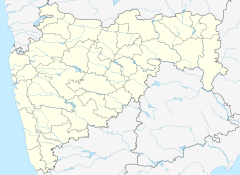Siddhivinayak Mahaganapati Temple (Titwala)
| Siddhivinayaka Mahaganapati Temple | |
|---|---|
| Name | |
| Other names | Titwaleshwar Ganpati |
| Proper name | Shri Siddhivinayaka Mahaganapati Temple, Titwala |
| Marathi | श्री सिध्दीविनायक महागणपती मंदिर |
| Geography | |
| Coordinates | 19°18′02″N 73°13′18″E / 19.30056°N 73.22167°ECoordinates: 19°18′02″N 73°13′18″E / 19.30056°N 73.22167°E |
| Country | India |
| State | Maharashtra |
| Location | Titwala |
| Culture | |
| Primary deity | Ganesha |
| Architecture | |
| Architectural styles | North Indian Architecture |
| History and governance | |
| Date built | original structure: Ancient (unknown) present structure: 1965–66 |
| Creator | Shakuntala on sage Kanva’s directive |
The Siddhivinayaka Mahaganapati Temple is a Hindu temple located in Titwala, a small town in the Kalyan taluka of Thane district – near Mumbai, Maharashtra, India. The temple is dedicated to the Hindu, elephant-headed god of wisdom Ganesha. Titwala is believed to be the putative site of the hermitage of sage Kanva, foster parent of Shakuntala who was born here. The place is steeped in ancient legend and the temple is frequented by a very large number of devotees on account of the belief that separated married couples could be united and marriages of desired people could be fixed easily if the Ganesha image installed in the temple is worshipped with devotion.
According to legend, this village was part of Dandakaranya forest where the Katkari tribe lived (the tribal hamlets are located even now close to the town across the Kalu river, approached only by boats).Sage Kanva had his hermitage here. Kanva was the author of several hymns of the scripture Rigveda and one of the Angirasas. He had adopted Shakuntala, who was abandoned immediately after her birth by her parents, sage Vishwamitra and the celestial damsel Menaka. Shakuntala’s story has been narrated in the Hindu epic Mahabharata and dramatised by Kālidāsa, considered the greatest poet and dramatist in Sanskrit language, in his play called the Abhijñānaśākuntalam (“The Recognition of Shakuntala").
King Dushyanta of Gandhara Kingdom while on a battle campaign was passing through the forests when he and Shakuntala fell in love with each other and got married according to the Gandharva rite (exchanging garlands as a marriage vow) in the hermitage. Since Dushyanta had to leave Shakuntala after some time due to unrest in his capital city, he gave Shakuntala a royal signet (a ring) as a sign of their love, promising her that he would return for her.
...
Wikipedia

